The young man shifts nervously in the front seat of the van as it turns down increasingly narrow roads, then alleyways, and eventually dirt tracks. His broad grin and swagger have faded since he first volunteered to lead us to the home of a local gachhi, a collector and seller of date palm sap. Leaning out the open window, he asks for directions from three men standing over the parts of a disassembled engine scattered on a dusty concrete floor, then from a man butchering chickens on a wood block out front of a roadside stand.
Whether our guide’s waning confidence is due to the fact that he doesn’t know the area as well as he first let on, or because revealing a local secret to a vanload of outsiders might be frowned upon isn’t clear. But after casting a few wary glances over his shoulder, he resigns himself to continuing our quest.
The gachhi we’re searching for is not just any sap collector. He’s rumored to make and sell tari, a fermented brew that’s popular among men in this part of northern Bangladesh—especially bus drivers, truckers, and day laborers—but one that’s prohibited for two reasons. In this predominantly Muslim nation tucked under the crook of India’s east arm, consumption of alcoholic beverages is forbidden (except by foreigners), so tari has always been technically off-limits. But now, even fresh date palm sap is banned because of its connection to an emerging infectious disease that is threatening to become the next global epidemic.
In 2005, scientists drew a link between this nearly universally loved local delicacy and Nipah virus encephalitis, a disease that has killed nearly 75 percent of those who have contracted it since 2001, when Bangladesh’s first outbreak occurred. Scientists’ understanding of the link between the sap—fermented or otherwise—and Nipah infection grew stronger as subsequent outbreaks mounted. But it wasn’t until 2011, in the wake of a particularly deadly winter, that the Bangladesh government declared a ban on the sale of date palm sap, an act akin to the United States government prohibiting the sale of apple cider.
Of course, banning a substance that’s loved by so many and enforcing such an order are two different things, particularly when the risks of consuming that substance are poorly understood. Which is precisely why this team of public-health investigators from an organization funded in part by the Centers for Disease Control and Prevention (CDC) has come here to the village of Mohonpur, near Bangladesh’s northeast border.
The team’s lead, Hossain M.S. Sazzad, a physician who also holds a master’s degree in health economics, leans forward and addresses the young man in the front seat in a calm, measured tone. He explains that he and his colleagues are not here to enforce the ban. They’re health workers, he says, and only wish to talk and learn.

(Photo: A.M. Ahad/bioGraphic)
When the track narrows to a width the van can no longer squeeze through, the team sets off on foot. We follow a path that cuts between thatch- and tin-roofed homes, past goat pens, and along spindly fences lined with reeds that have had dung hand-molded along their lengths and been left to dry in the sun—fuel for another day. Dogs bark, and women and children wrapped in brightly colored cloths come to observe the spectacle of city folk traipsing through their village. Eventually, the team turns down a narrower side path leading to a dwelling that several villagers have pointed them toward. The whereabouts of the local gachhi, it turns out, is not a particularly well-kept secret.
They find the sap collector behind his house hacking at a stack of thick, green bamboo cuttings piled on the ground. While his greeting is less hospitable than is customary in Bangladesh, he seems more perplexed than annoyed by the unannounced visit.
As if amiably chatting with a farmer about the weather and his crop, Sazzad asks the man about his daily activities, his health, his method of sap collection, if he’s heard about Nipah virus, if he ever observes bats near the trees he taps.
Standing a pace or two away from the group, the old man, his white hair and beard glinting in the dappled sunlight, says that he’s been climbing and tapping date palms on this land since before the country’s 1971 War of Independence. He’s now 85. As evidenced by more than a dozen clay pots lying on the ground behind him, he admits that he still collects sap daily during the winter, but now only for personal consumption, and claims he doesn’t ferment it to make tari.
A few moments later, though, the man asks if anyone in the group wants to purchase sap from the haul he collected the night before. When they decline, his scant interest in the conversation vanishes entirely. He turns, gathers up his tools—a handful of clay pots, a long, curved knife he uses to carve away the bark of date palms, and a rope that will loop around his waist and the trunks of the trees as he climbs them—and sets off to make his afternoon rounds.
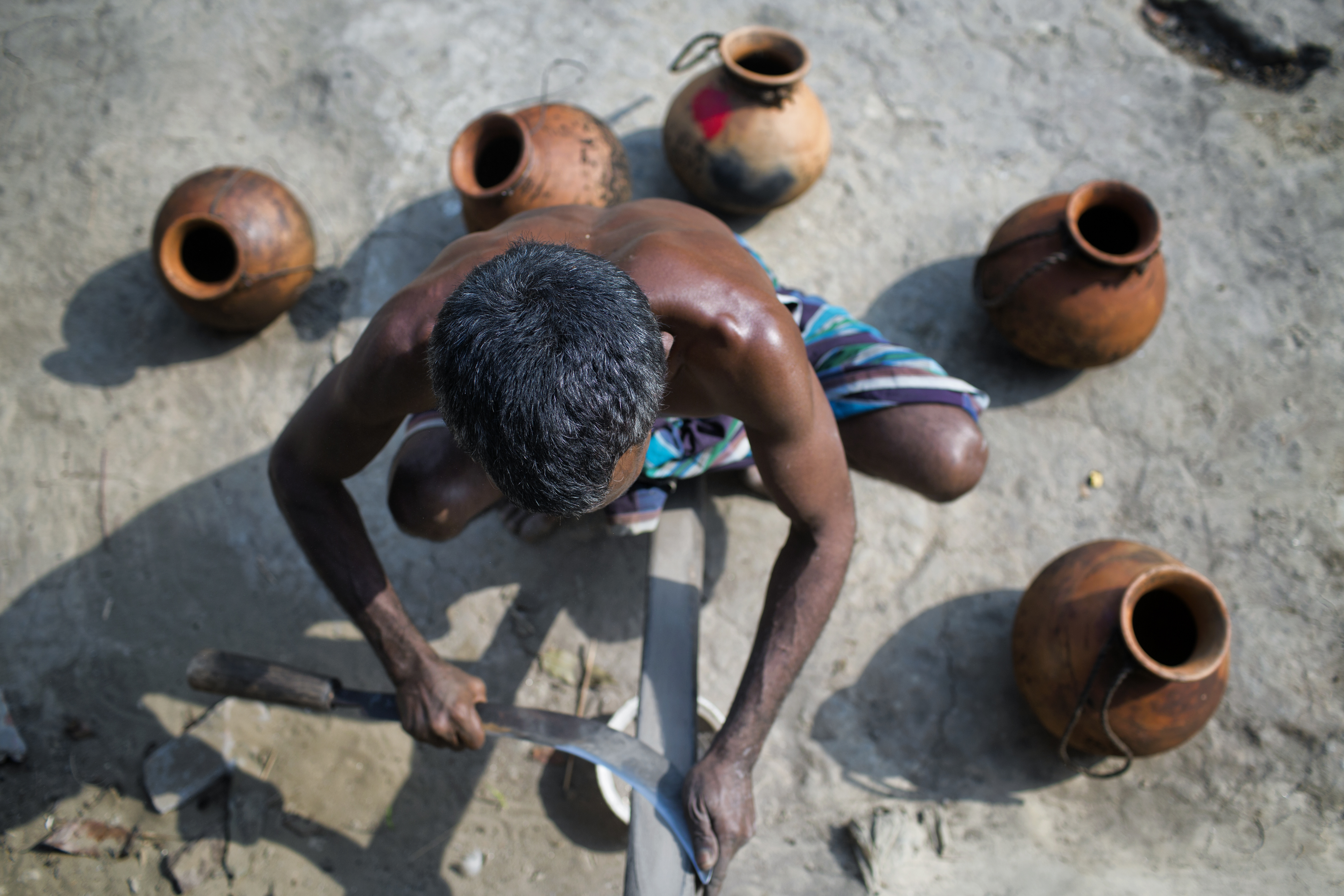
(Photo: A.M. Ahad/bioGraphic)
This brief exchange feels anticlimactic to me, especially after our long search for the source of a potentially fatal outbreak. Sazzad and the others don’t seem fazed, though. In a way, it’s emblematic of the inconclusive and unfinished nature of the work they do—and its importance. Yes, the gachhi will continue collecting, and likely selling, date palm sap. But now they know exactly where he lives, and that this is an area they will need to keep an eye on.
While the man is not the villain I may have envisioned when we were searching for him—just an old man looking to make a few extra Taka by tapping the local trees—these health workers, and health officials around the world, know that the next outbreak could begin with him, or someone just like him. And although Nipah virus has killed fewer than 400 people since it was first identified 20 years ago, they also know that the pathogen’s persistence in the environment, its ability to change quickly, and its potential, under the right set of conditions, to spread like wildfire could enable the next outbreak, or the one after that, to become a pandemic. Many experts think that the right set of conditions might already be in place here and across a vast swath of western Bangladesh known as the “Nipah Belt.”
As we make our way back through the village, I can’t help retracing the steps I took to get here. It’s just a few kilometers and a very plausible route from this tiny village to a city center and onto a crowded bus through one of the most densely populated countries in the world, then on to the country’s capital of nearly nine million, and possibly onto an international flight bound for another metropolis. It took me two days to travel that route in the other direction—well within the virus’ incubation period.

Nipah virus encephalitis is one of eight diseases that the World Health Organization has identified as epidemic threats in need of prioritization. The list includes Ebola, SARS, Zika, and an as-yet unknown affliction referred to as “Disease X.” All eight have been prioritized because of their inherent epidemic potential, and also the fact that there are currently insufficient measures in place to prevent them.
While the WHO’s “priority pathogens” vary in terms of their geographic distribution and the havoc they inflict on the human body, they have a couple of things in common that enhance their epidemic potential. First, they’re all viruses (or likely to be in the case of Disease X). Second, they’re all zoonotic, which means that they all reside in another animal, but are capable of jumping, or spilling over, into humans. These characteristics are important, because viruses reproduce very quickly, which amplifies their potential to change into more pathogenic forms. And a reservoir host acts like a bunker, a safe haven between outbreaks, in which the pathogen can regroup and potentially undergo a change, a random mutation that will better prepare it for the next spillover opportunity.

(Photo: A.M. Ahad/bioGraphic)
Nipah virus’ safe haven is the fruit bat, or, more accurately, several species of bat in the genus Pteropus. Fruit bats, also known as flying foxes, are small- to medium-sized herbivorous mammals that roost in trees by day and take to the wing by night in search of nectar, pollen, and fruit. According to Emily Gurley, an epidemiologist at Johns Hopkins Bloomberg School of Public Health who has been studying Nipah in Bangladesh since 2004, most bats in the genus Pteropus carry antibodies for Nipah or other closely related henipaviruses. That means the bats have at least been exposed to the pathogen, and many harbor live viruses in their tissues.
Gurley and other scientists think that fruit bats have carried Nipah virus for a very long time. “The bats have always had it,” she says. Not only that, she suspects that the virus began spilling over into humans hundreds of years ago, if not more. Until recently, though, there were likely fewer opportunities to do so. There was also no diagnostic test for the virus, and so, like trees falling in the forest with no one to hear, when spillover events did occur, they went unnoticed.
After its early, unheralded debuts, Nipah virus found its big opportunity in 1998 in the tiny Malaysian village of Sungai Nipah from which the virus acquired its name. The factors that led to that first big spillover event are unfortunately all too familiar in the histories of zoonotic pathogens, currently responsible for 75 percent of all emerging infectious diseases. As the number of humans on the planet has exploded toward and then beyond seven billion, we’ve increasingly pushed into and degraded natural ecosystems, causing many organisms to go extinct, and putting ourselves into close contact with those that remain. The lifeforms we now co-habitate with include both the animals and plants we can see, and the microbes they harbor, which we can’t.
According to Kevin Olival, an ecologist and evolutionary biologist for the non-profit organization EcoHealth Alliance, it was this type of ecological shift that led to Malaysia’s 1998 outbreak. Olival, who has studied routes of transmission from bats to humans all over the world, says that “contact between these animals and people has probably always happened to some degree because we both eat fruit—so there’s always been some overlap.” But, he says, industrialized agriculture near forest edges over the past several decades has dramatically altered that interface, intensifying contact between bats and humans.
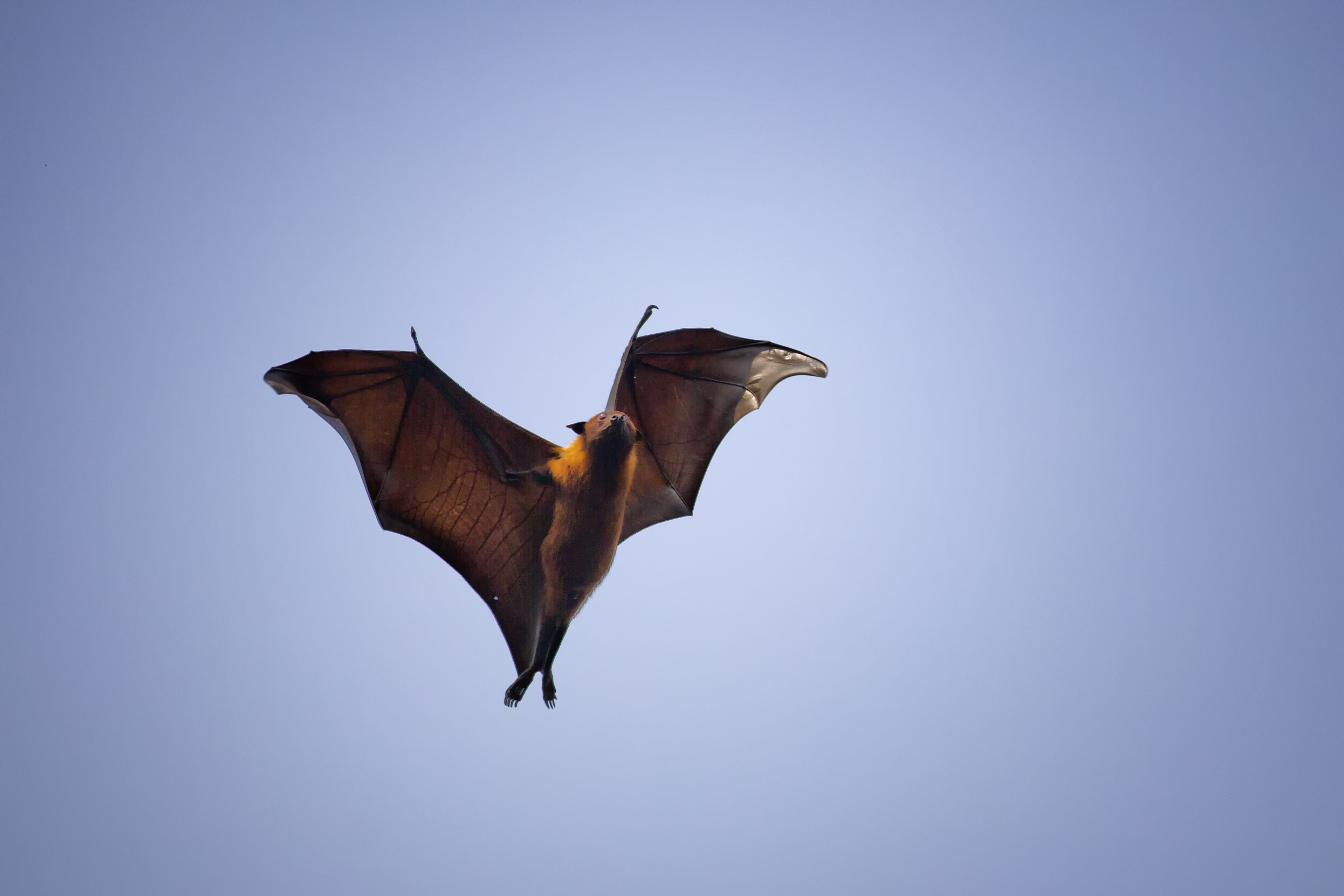
(Photo: A.M. Ahad/bioGraphic)
In the mid- to late ’90s, pig farming was booming in Malaysia. Farmers cleared forest to make way for more and larger operations. This not only put the farms in closer proximity to the wildness of the rainforest, it reduced the number of fruit and nectar trees available to bats. Drought and fires in Indonesia in preceding years also contributed to food shortages and caused bats to migrate greater distances in search of flowering and fruiting trees. Many of them found what they were looking for around Malaysian pig farms, which were often lined with mango trees. The bats, at least some of which carried Nipah, feasted on the cultivated fruit. And if a bat-nibbled mango dropped into a sty from the tree above, a pig had a chance of picking up the virus along with a tasty snack.
Infected pigs suffered acute respiratory distress, like a horrible case of the flu. The vast majority of animals on stricken farms became infected, and 20 percent of those that fell ill died. Farm workers who handled sick and dying pigs fared even worse. After an incubation period of several days to more than a week, many workers who were exposed developed encephalitis, an often-deadly inflammation of the brain.
Encephalitis is common in Nipah sufferers. But in 1998, no one had ever heard of Nipah virus, and it wasn’t clear how people were getting sick in the first place. Doctors initially suspected an outbreak of Japanese encephalitis, a mosquito-borne disease. Eventually, though, when the infections were linked to direct contact with pigs, they realized they had something different on their hands. Identification of the virus in the cerebrospinal fluid of an outbreak victim confirmed that the pathogen was not only new to science, it was of a type known to be carried by mammals, not mosquitoes.
With this telling but incomplete knowledge in hand, the Malaysian government took a bold step. It ordered the slaughter of more than a million pigs in the hope of preventing a national or global health crisis. Like amputating a limb to stop a rampant infection, the move crippled the country’s booming pork industry in a matter of weeks. But it also stopped the Nipah outbreak in its tracks. By May of 1999, the nightmare was over. Unfortunately, this would not be the last the world had seen of Nipah virus.
The pathogen reemerged in two separate outbreaks in 2001, one in Siliguri, India, and another in Meherpur, Bangladesh. Although the infectious agent was confirmed to be Nipah virus, there were some alarming differences in these new outbreaks. First, neither India nor Bangladesh had large-scale pig farming operations, so there was no obvious intermediate host. More troublingly, the new outbreaks, though significantly smaller than Malaysia’s, had much higher fatality rates—about 70 percent. What’s more, a number of cases in Siliguri resulted from caregivers being infected by patients. The virus had jumped from person to person.

(Photo: A.M. Ahad/bioGraphic)
Although Nipah was at the heart of each case, the virus was clearly behaving differently from place to place, outbreak to outbreak. And that pattern, or lack thereof, has continued over the past 17 years. Bangladesh has seen at least one new Nipah outbreak nearly every year since 2001. India has documented several more as well, including one this past summer that killed 17 of the 19 people who were infected.
What this variation and regular recurrence means is that health workers like Sazzad and Gurley never quite know what to expect from their moving target. “In Bangladesh, we have documented closing in on a hundred different spillover events,” Gurley says. “So, that’s a hundred different opportunities for a more transmissible strain to be introduced into people. And that’s scary.”

A lone figure in a long silk shirt and tupi hat pedals silently down a road of damp, red clay packed hard by ages of foot and wheeled traffic. He rides past a great egret probing the surface of a flooded rice field, and between towering fig trees and houses still quiet under a blanket of cook-stove smoke and pre-dawn mist.
In the morning stillness, it’s hard to believe that the chaotic crush of Rangpur City is just a short, harrowing five-kilometer drive from here. There, pushcarts and auto rickshaws and lumbering trucks filled with bricks will soon begin jockeying for position in front of merchant stalls, some peddling mobile phones, others cooking biryani and flatbread over open fires. Here, the chaotic competition is of a different kind—ecological, otherworldly.
Above our heads, hundreds of fruit bats are coming home to roost. Their translucent wings stretch wide as they maneuver between careening bodies and twisted tree limbs before braking hard, grasping with outstretched feet, and awkwardly hanging themselves upside down for the day. As disorderly as the bats’ morning approach may seem, the real scrum begins when they land. Someone’s always too close, or hanging in a prime patch of sun or shade. Often the only way to regain one’s rightful place in the roost is with a warning screech or a swift nip or wingslap.
Fortunately for these bats, the antagonism remains within the colony. This group of Indian flying foxes has been lucky enough to take up residence in an enormous sacred fig tree, which sits at the center of a local Hindu temple. Though the fig’s twisted trunk brings to mind the menacing trees from The Wizard of Oz, the temple’s low, deteriorating walls demarcate a peaceful place in which the tree and its many inhabitants can live out their existence free from harassment.
While the temple offers an extra level of protection, people in Bangladesh are generally resigned to living among bats. “They’re everywhere,” Gurley says. “There’s hardly any village, among the hundreds we’ve visited, that doesn’t have a bat roost.”
Driven by a lack of primary forest and reliable food resources across much of their native range, the bats likewise seem resigned to living near people. Just like their relatives in Malaysia, bats in this region frequently take advantage of cultivated crops such as mangoes and figs to make up for the native fruit and nectar missing from their diets. Many have also developed a taste for date palm sap.
In 2004, when Gurley first began studying Nipah in earnest, she and her team of investigators quickly zeroed in on that bat-sap connection. They asked Nipah survivors and loved ones of the deceased about direct contact with bats, about tree climbing, about living near bat roosts and eating fruit that had fallen from trees. They also asked about consumption of date palm sap. Of all the activities the team explored, sap drinking was one of the most consistent among those who had fallen ill.

(Photo: A.M. Ahad/bioGraphic)
The clearest evidence of sap contamination, though, came in 2010 when researchers set up infrared cameras trained on the collection pots that gachhis had hung on date palm trees. The results of this study couldn’t have been more telling. Over 20 nights of observation, the cameras captured 132 visits from fruit bats on 14 separate nights. Bats could be seen lapping up the sweet sap oozing from the sections of tree trunk where the gachhis had shaved the bark away. In some instances, the images captured bats in the act of relieving themselves directly above the collection pots. The contamination was unintentional, of course, but the possible route of transmission was undeniable.
Among mammals, bats rank No. 1 in terms of their role in spreading zoonotic diseases. Scientists have linked them to at least a dozen human afflictions, including four of the eight diseases the WHO has prioritized. Exactly what makes bats such good hosts for disease-causing agents—or if, in fact, they are particularly suited to carrying and transmitting disease—has been poorly understood for decades. But new research suggests that the answers may have something to do with flight.
While a number of mammals can glide, bats are the only members of the group capable of sustained flight. This feat requires a huge amount of energy—a 16-fold increase in metabolic rate, according to Raina Plowright, a veterinarian and professor of epidemiology at Montana State University. That high sustained output would typically be associated with oxidative damage to cells, she says, but somehow bats have developed mechanisms to prevent or repair the damage.
Bats are also long-lived compared to similar-sized mammals. As a general rule, the more you weigh, the longer you live. But bats are complete outliers in that respect, Plowright says. For example, the oldest known bat, which lived 41 years, weighed less than eight grams. This suggests that bats have a way to combat the cell damage that typically leads to senescence. “We think that somehow this ability to not have oxidative damage and the ability to repair DNA and not go into senescence are tied up,” she says, “and perhaps even tied up with their ability to host viruses.”
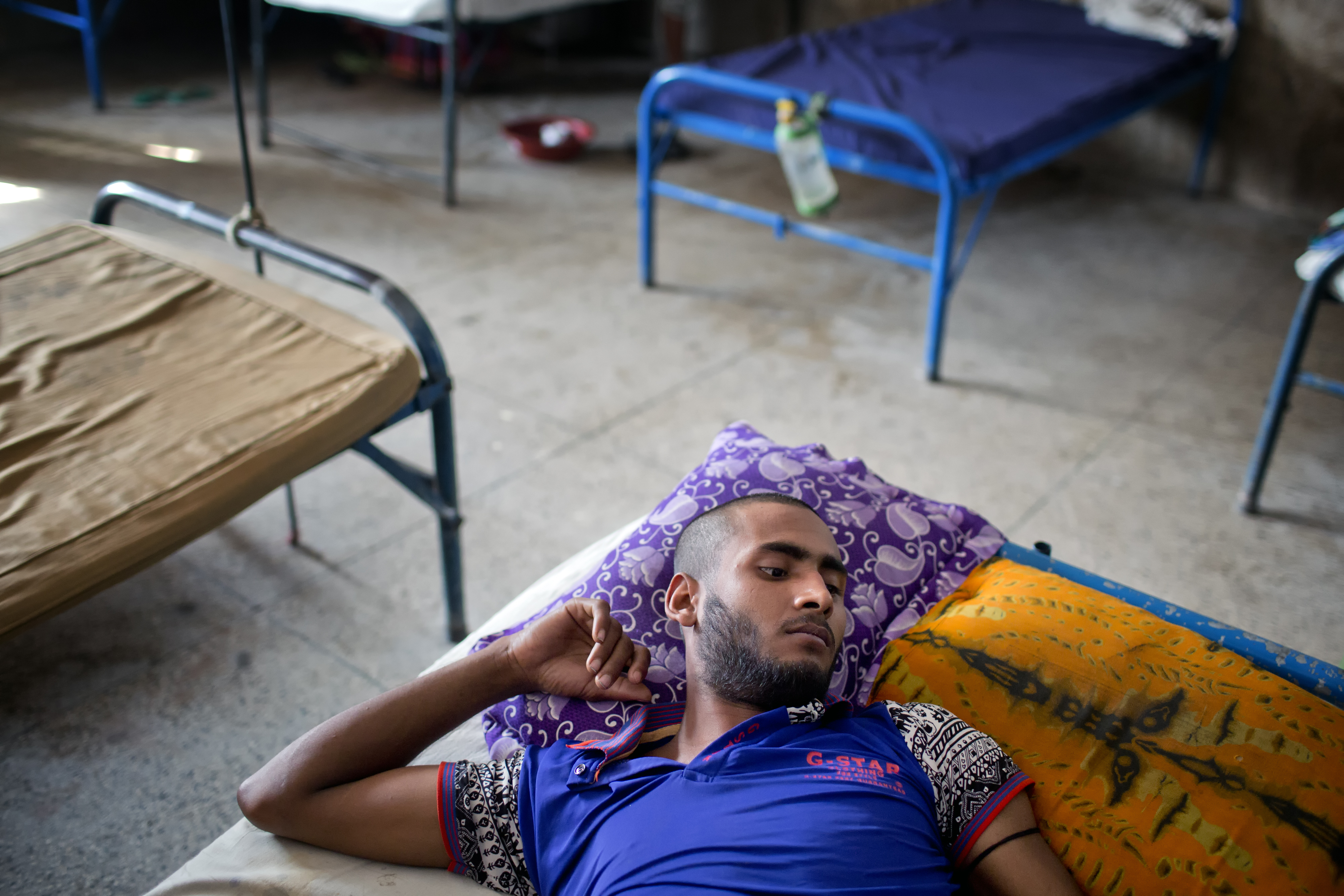
(Photo: A.M. Ahad/bioGraphic)
Because bats typically live in large colonies and roost in close proximity to one another, microbes are easily passed among members of the group. While virus numbers are typically kept in check by each bat’s immune system, when an animal is stressed, its defenses can become compromised. Much as a cold might make us cough and sneeze, a bat’s weakened immune system can cause the animal to shed viruses into its surroundings through saliva, urine, and feces.
According to Plowright and Gurley, bats tend to shed viruses in pulses, high concentrations of the pathogens excreted by a colony into the environment over a short period of time. These pulses seem to coincide with Nipah outbreaks, but what stresses the bats in the first place is unknown. Plowright suspects an ecological cause, possibly related to food. “We don’t know much about their response to the environment and nutrition,” she says. “Maybe we see high rates of excretion in winter because there’s less food available. We just don’t know.”
Those unknowns are, of course, what flash through my mind on this winter morning as I stand there gawking up at hundreds of bats that have just returned from a night of foraging. I glance down at the backpack I carelessly dropped into the perpetually damp soil at the base of the tree when I first arrived. Now I can’t help wondering: How much virus does it take to get sick? How much am I breathing in now? Unfortunately, not even the experts have the answers to these questions.
Two weeks from now, when I’m back in the U.S. and most likely safely outside the virus’ incubation period, I’ll quiz Gurley about my activities that morning—and the mist that I may or may not have felt as I stood under the roost. Choosing her words carefully, she’ll explain that bats do tend to urinate more frequently in the morning. “So, they leave the roost at night to feed, right? And when they come back, that’s typically when they urinate so … yeah, I probably wouldn’t do that again….”

In January of 2010, Sazzad found himself in the midst of one the most uncomfortable moments of his career. Sitting in an isolation room at the Faridpur Medical College Hospital, wearing gloves and an N95 surgical mask designed to prevent the spread of airborne viruses, the soft-spoken, then-33-year-old doctor was interviewing a patient who suffered from fever, dizziness, and shortness of breath. The man’s nephew had died from Nipah virus encephalitis about a week earlier, as had three other people from the same village. By the time the patient arrived at the hospital in Faridpur, he was so disoriented that his responses to Sazzad’s questions were mostly nonsensical. In 2010, knowledge was limited about how Nipah manifests in the human body or how it spreads. Still, Sazzad knew more than enough to be cautious.
But it was stuffy in the isolation room, and Sazzad, who was coming down with a cold and was feeling pretty lousy himself, felt like he was suffocating behind his mask. Twice during the stifling, hour-long interview, the urge for fresh air became so overpowering that he slipped the back of a pen under the edge of his mask to create a small gap. Just a quick breath, he thought.
The next morning, Sazzad learned that the patient had died, and a diagnosis was confirmed. Nipah virus had been raging through the man’s body during the interview. When the young doctor started coughing that night, a concerned colleague called Sazzad’s adviser Stephen Luby, a professor of medicine at Stanford University who at the time was stationed at the CDC office in Bangladesh, to ask what to do. They all told themselves it was just a cold, but Sazzad couldn’t stop thinking about those two breaths. Or about his wife and one-year-old son at home. Eventually, a blood test put their anxieties to rest. But all these years later, when he tells me the story as we tour a hospital ward just two floors above that isolation room, he still visibly shudders.
A member of a Nipah-focused team of doctors and scientists based at the International Centre for Diarrhoeal Disease Research, Bangladesh, Sazzad is one of about 20 staffers charged with investigating and following up on suspected Nipah outbreaks across the country—all on an annual budget of $150,000 per year. That’s no small task in a nation that’s roughly the size of the state of Illinois and packed with a population that’s more than half that of the entire U.S.
Interviews with sap collectors, potential Nipah victims, and past outbreak survivors are a key part of the team’s efforts to understand the disease and its transmission. Despite having conducted more than a hundred of these high-stakes conversations, Sazzad still sometimes feels nervous. “When you are just inside an outbreak,” he explains, “when you don’t know the whole picture of who’s transmitting to whom, you feel very unsafe, because you don’t know if you have been exposed or not. You could be part of the chain.”
Despite the risks, Sazzad and his colleagues persist, because they know the next conversation they have or observation they make may mean the difference between life and death for someone—or many. They also know their front-lines work is leading to a much clearer picture of the way the virus works, providing the basic information necessary to help stop a future epidemic.
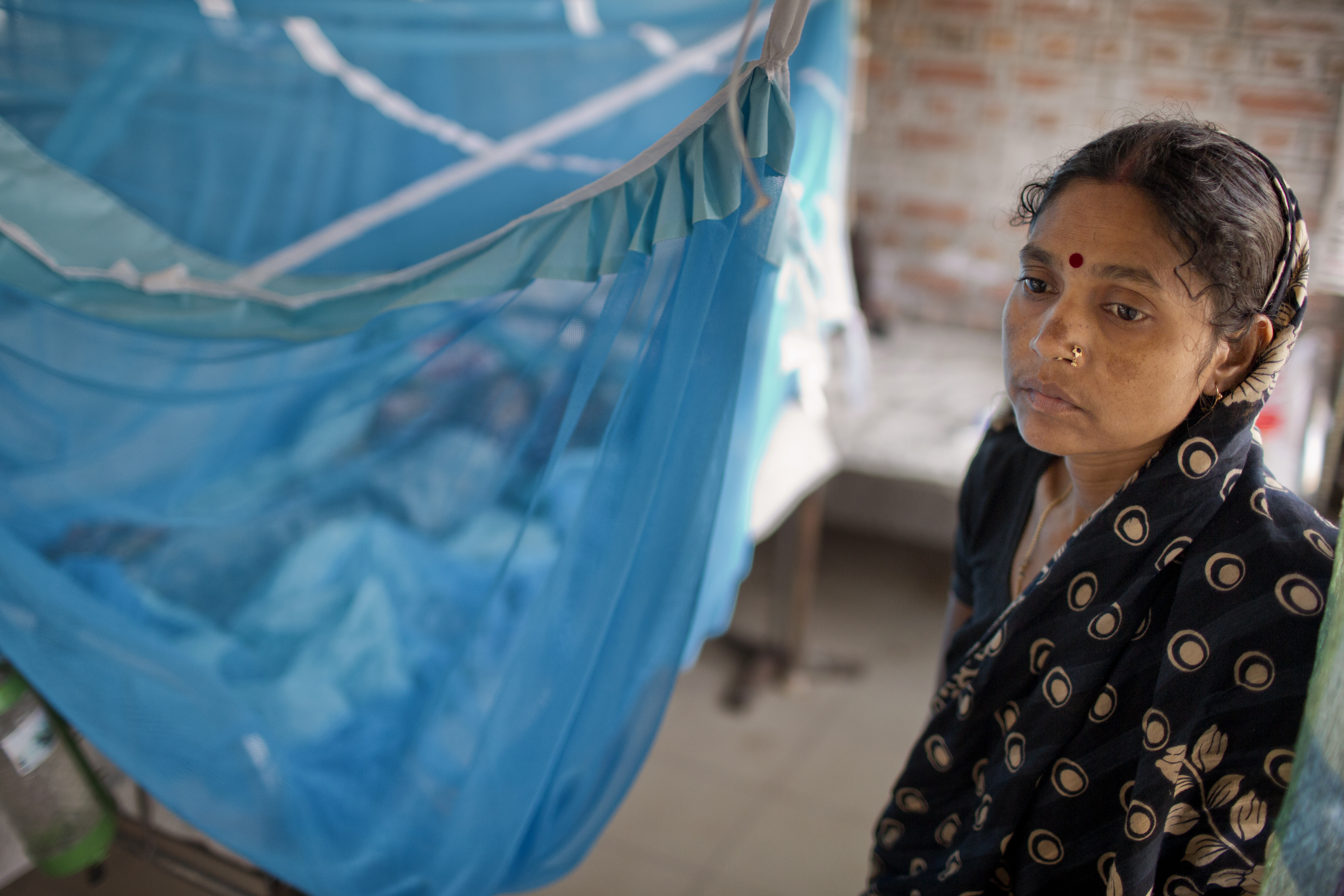
(Photo: A.M. Ahad/bioGraphic)
The symptoms of the disease are now well documented, although they vary considerably from patient to patient and strain to strain. While some infected humans are completely asymptomatic, most initially develop symptoms including fever, headaches, vomiting, and sore throat. Some develop acute respiratory infections in the early stages of the disease; others never do. After a few days to a couple of weeks, many patients start to exhibit more serious signs of encephalitis—dizziness, drowsiness, altered consciousness, and other neurological changes. Within another day or two, the disease often progresses to coma, then death.
Transmissibility is also highly variable. While the world has yet to see a strain of Nipah virus that is especially proficient at jumping from human to human, many past spillover strains have managed to make that leap, traveling in fluids spewed from a mouth or nose, or through urine or blood. “Immunological studies have shown that the primary route of human transmission is through saliva,” says Sazzad, “but we still don’t know if a fraction of cases are caused by airborne transmission. Is there any additional route of transmission? We don’t know.”
So far, most documented person-to-person transmission has been from patient to family caregiver. Even in hospitals, patients are more likely to receive direct care from a family member than a doctor or nurse, partly because of staffing levels at the hospitals and partly because of cultural taboos around physical contact with strangers.
As Sazzad and I walk the concrete halls of the Faridpur Medical College Hospital, I recall a pre-trip conversation with Gurley, who told me that one of the biggest challenges her team faces in their infection-control work in Bangladesh is that family members, and in many cases even the health workers, caring for Nipah patients “don’t understand contagion and how diseases are being transmitted.” Mothers hand-feed food to sick children, then finish the leftovers themselves. Daughters use the long folds of their skirts to wipe mucus from a dying parent’s face, then use the same skirt to wipe their own tears moments later.
Now that I’m here, it has become abundantly clear that it’s not only possible for person-to-person transmission to happen inside hospital walls—it’s likely.

According to Gurley, who led the Surveillance and Outbreak Investigation Unit and directed the Programme on Emerging Infections at ICDDR,B from 2003 to 2015, it’s not a matter of if there will be another pandemic on our crowded and degraded planet, it’s a question of when, and which disease it will be—Ebola, Disease X, Nipah? She’s spent the past 15 years, first at ICDDR,B and now at Johns Hopkins, doing everything in her power to make sure it’s not Nipah.
After my trip, having seen everything she’s up against, I comment that I’m amazed by her ability to stay motivated in the face of such monumental challenges.
She laughs. “I think the word you’re looking for is ‘stubborn,’ right?”
Her persistence is unquestionably derived, in part, from her self-described love of big, hairy problems. “I guess I run under the assumption that if there’s a good reason to do something, then there’s gotta be a way to figure it out,” she admits. But she reminds me that she has reasons to be optimistic about the progress they’re making.

(Photo: A.M. Ahad/bioGraphic)
While there’s never enough money to go around, and while Gurley and Sazzad both lament the fact that sexy projects like vaccine development are much easier to secure support for than things like hospital infrastructure and disease surveillance, total funding for Nipah research and response is at an all-time high. Most of the other diseases on the WHO watch list still attract far more attention than Nipah, but at least, says Gurley, “it’s on the radar.”
Additionally, thanks to intensive surveillance efforts over the past 15 years, Gurley says we now know more about how to stop Nipah than we do many other emerging infectious diseases. “We know how to prevent transmission of Nipah from wildlife to people,” she points out. “Can we do that for Ebola? No. And it’s because we haven’t spent the same time with other diseases monitoring every single case and looking into it.”
But knowing what needs to change and convincing people to make those changes are two very different matters.
Once Gurley’s team determined that bat-contaminated date palm sap was the culprit in most, if not all, Nipah outbreaks, they launched an educational campaign urging people to stop drinking raw sap. But since they knew most people would continue to risk drinking the delicacy, they also started looking into possible “safe sap” options.
For decades, some gachhis have wrapped their sap collection pots in protective shields that resemble bamboo placemats. They’ve done so not because they were worried about disease transmission, but because they wanted to keep bats and birds from drinking and dirtying their hard-earned sap. Most gachhis rarely took this precaution, presumably because scaling towering date palm trees is hard enough without lugging extra equipment up the trunk. But when field studies proved that the skirts reliably kept bats out of the sap, Gurley’s team began campaigning to make that practice the norm.
They visited dozens of gachhis in many dozens of villages to pitch them on the benefits of safeguarding their sap collection pots with bamboo skirts. They produced posters and aired docudrama public-service announcements with soap-opera-style storylines warning people of the dangers of drinking unprotected sap. They hired locally trained anthropologists to help them frame their messaging in the best possible way. And their efforts have helped, a bit. But, says Gurley, “getting people to change what they do when it’s culturally ingrained is really hard. Really, really hard. I mean, people still smoke cigarettes. People still start smoking cigarettes!” In Bangladesh, gachhis still collect sap all across the Nipah Belt, most often without bamboo skirts. And in each of those villages, people still consume unsafe sap.
Behavior change is also a major factor in the team’s efforts to prevent person-to-person transmission. Installing portable hand-washing stations, or even running water, in hospitals, for instance, will only help control infection to the extent that health workers can convince people to start washing their hands. The same is true for ongoing efforts to develop faster diagnostic tests that would allow for earlier diagnosis and reduced transmission opportunities—those tests will only matter if health workers can convince more people to seek treatment. “A hospital in Bangladesh, it’s a really unpleasant place,” Gurley says. “If you’re in the context of an outbreak, and everybody who’s gone to the hospital has died, why would you go?”
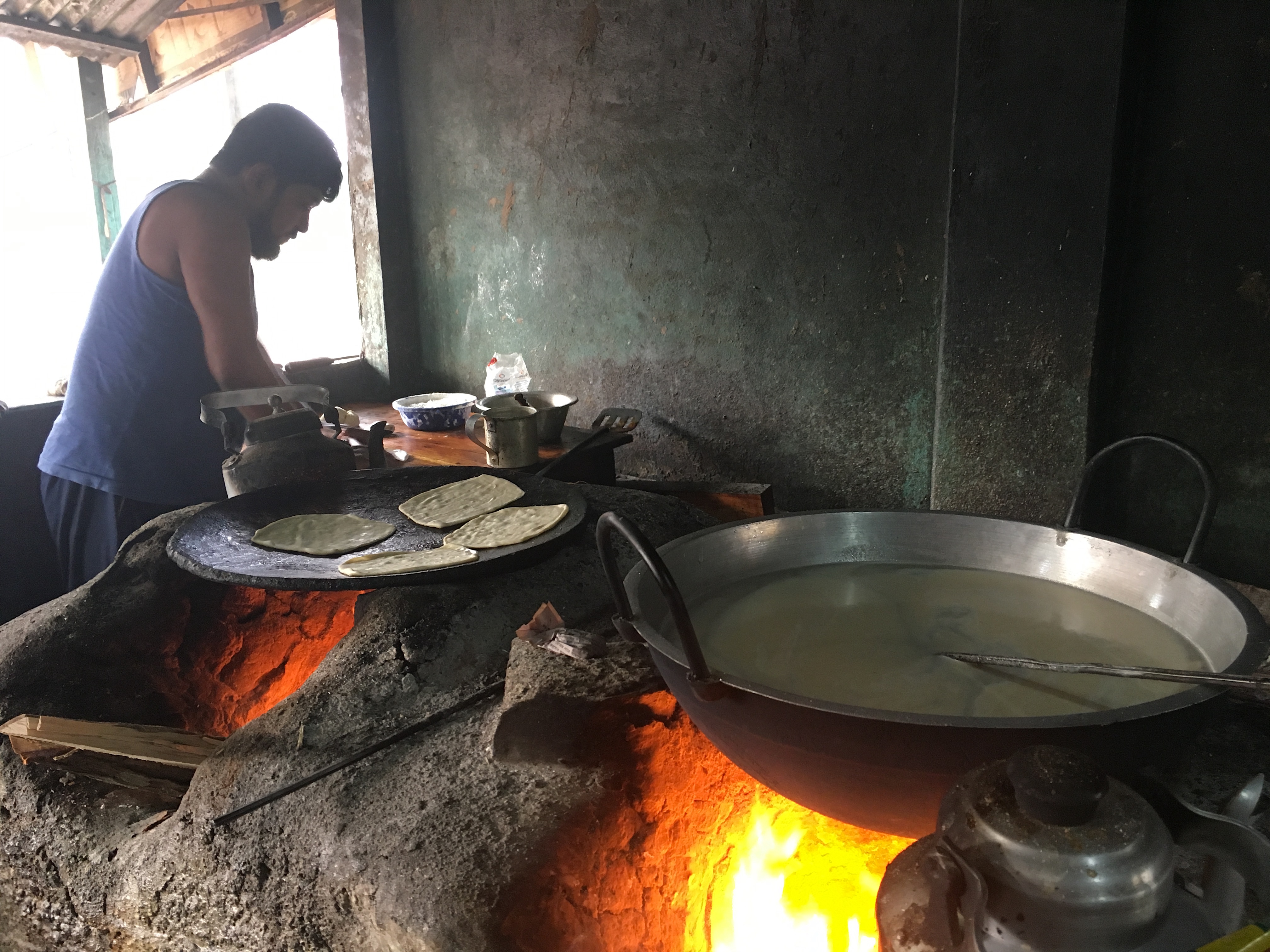
(Photo: A.M. Ahad/bioGraphic)
One key to incentivizing hospital visitation, says Gurley, is the development of therapeutic drugs that could at least treat, if not cure, the disease. “Realistically, medical facilities currently have very little to offer people with Nipah. They can provide some basic supportive care, but most of these people are going to die,” she says. If better treatment options were available, more patients might be motivated to seek medical care, which would improve both surveillance efforts and the potential for better infection control.
As a member of WHO’s Nipah Virus Taskforce, Gurley is currently advising on efforts to develop both therapeutic drugs and vaccines. The latter now has the benefit of a $25 million grant from the Coalition for Epidemic Preparedness Innovations for the development of a candidate vaccine, which is projected to be ready for human trials within the next five years.
When asked if a vaccine is likely to solve the Nipah problem, Gurley is quick and decisive with her response. “A vaccine itself is never going to be the only answer. The only disease we’ve ever eradicated with a vaccine is smallpox.” It would certainly help, especially to be able to inoculate the health workers, like Sazzad and his medical technicians, who regularly come into contact with or treat Nipah patients. But, she says, infection control and surveillance are always going to be important, as are diagnostics and therapeutics. “All these issues are linked together. In some ways that’s daunting, and in another way, it can give us some optimism that if we make progress in just one area, it will reinforce all the others.”
Undoubtedly, the progress that’s been made over the past two decades in understanding Nipah virus and implementing infection control interventions has saved countless lives. Still, though, the potential for a catastrophic outbreak looms large.

In 1994, Hendra virus—a deadly, bat-borne disease that is closely related to Nipah—jumped from bats to domesticated horses for the first time (at least as far as anyone knew). Endemic to Australia, the virus has since killed more than a hundred horses and has made the leap from livestock to humans on seven occasions. As the outbreaks began to mount, Raina Plowright returned to her native Australia to study the dynamics of Hendra virus transmission. Since her path to infectious disease research included a degree in veterinary medicine, and a master’s in epidemiology, she was quite possibly the perfect person to take on this challenge for her Ph.D.
After assembling a diverse team of collaborators, including veterinarians, range managers, behavioral ecologists, and virologists, Plowright set out to identify the factors that had regularly, but so far unpredictably, led to Hendra spillover. As the research progressed, she observed that each of her colleagues viewed the virus through the lens of their particular specialty, and most seemed to view the piece they studied as the most important one—the factor ultimately responsible for spillover.
To gain a more complete view of Hendra transmission, Plowright forced herself to step back a pace or two. Suddenly she began to see the virus’ route from bat to human as a series of barriers through which the pathogen must pass to move from reservoir host to recipient. The concept that Plowright sketched that evening before it could once again fade from view was a stack of widely spaced layers. Like slices of Swiss cheese, each layer was pockmarked with holes that represented potential routes the virus might exploit to move on to the next step.
The arrangement of the layers in Plowright’s mind was anything but arbitrary; it was hierarchical. In other words, if a virus was unable to circumvent any one barrier, spillover would be impossible—and none of the other barriers in the chain would matter, regardless of how porous they might be. The uppermost layer in Plowright’s model, for example, represented the distribution of a reservoir host population, specifically its proximity to people or domestic animals. No matter how transmissible or virulent a virus might be, if a reservoir host had no contact with a recipient, spillover couldn’t happen.
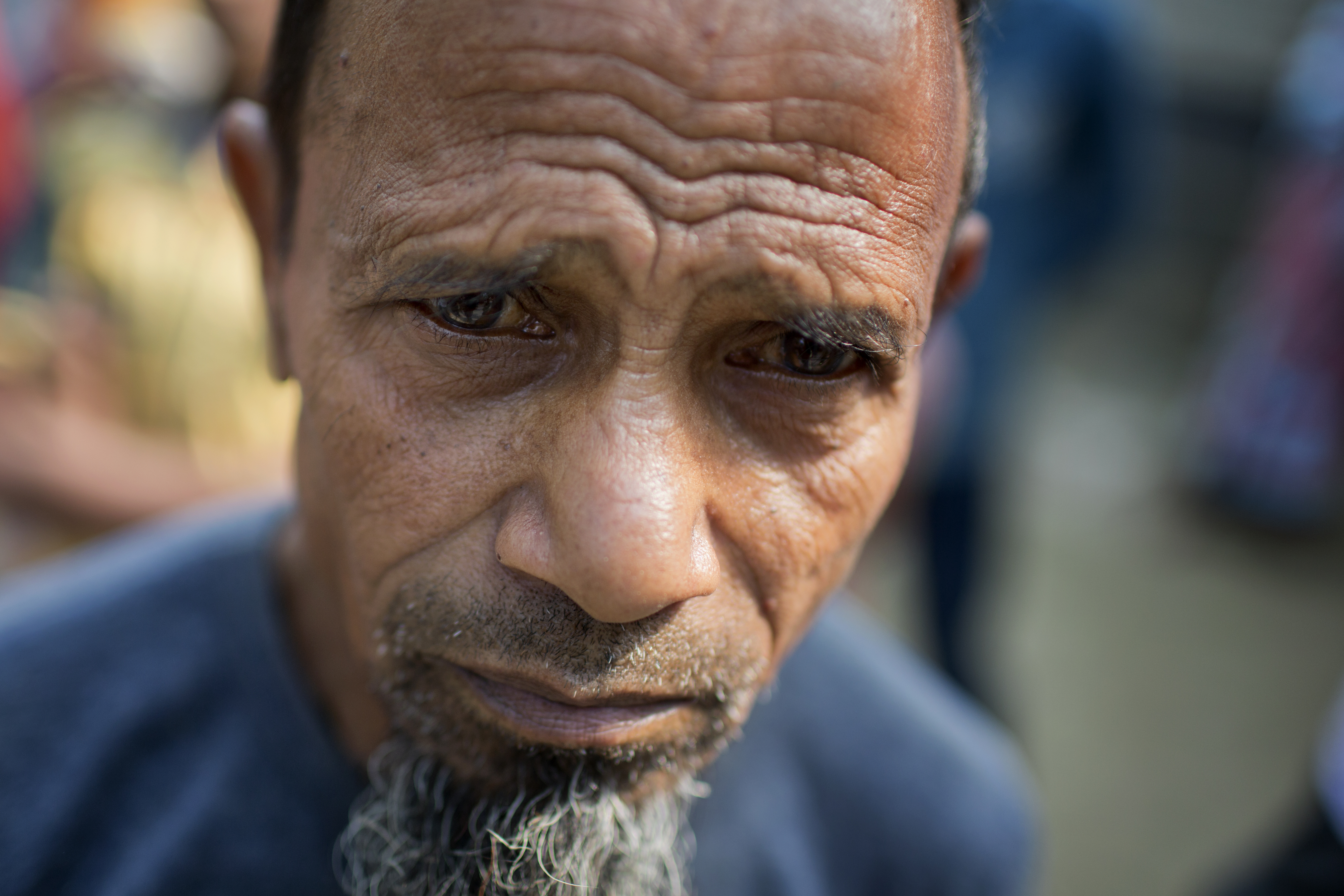
(Photo: A.M. Ahad/bioGraphic)
The many layers that Plowright sketched that evening illustrated why spillover isn’t inevitable; it’s actually quite difficult, and rare. Not only does a virus need to find a route through each barrier, but those Swiss cheese holes need to be aligned with one another in space and time. The virus can only get through if it has a straight shot. “It’s kind of a no-brainer,” Plowright says now. “Of course that’s how it works.”
Still, the more she looked at her sketch, the more she felt like she was onto something important. She could see how various changes in the environment, or the virus’ genetic make-up, or the recipient host’s immune response could influence the size and position of those holes, making it easier or more difficult for spillover to occur. The framework was not only an intuitive way to think about zoonotic disease, Plowright thought, it might also help researchers pinpoint the most effective ways to close off those routes of transmission and prevent spillover from happening in the first place.
Historically, our battles against infectious diseases have largely been waged at the level of the recipient host—the person who has fallen ill or who might become infected in the future. That’s the level that medical care, drug therapies, and vaccines target. Plowright is quick to acknowledge the critical role that medical and public-health workers play in disease prevention. “But,” she says, “we think we could probably prevent spillover at the top, at the level of the reservoir host … rather than at the lowest level of recipient-host susceptibility.”
For the past 25 years, one of Plowright’s collaborators, a bat ecologist named Peggy Eby, has documented the rapid decline of native forests in eastern Australia, and the dramatic shifts in bat populations that have followed. Plowright suspects that this ecological degradation has been a major cause of the increased incidence of Hendra virus outbreaks. “Something has switched in the system,” she says. “Bats are now staying closer to their food sources because the habitats that provided high-energy nectar in the winter are mostly gone.” That switch has put Australia’s bats in closer contact with people and domestic animals as the bats supplement their diets with cultivated fruits and ornamental flowers.
Although there are surely many environmental factors involved in Hendra transmission, the timing and location of several recent outbreaks has led Plowright to key in on one in particular: food. “For some reason, it’s the winter after nutritional stress events that seems to be the worst for Hendra spillover.”
Another observation that supports the connection between food availability and Hendra outbreaks also hints at a potential ecological intervention—one that could reduce viral shedding and pull bats back out of cities and into more natural habitats. Eby observed that, when spotted gum trees flower, an event that occurs every few years, the bats empty out of cities to take advantage of this rich food source. Now the scientists are exploring ways to mimic this effect by encouraging agencies and organizations working on reforestation projects to incorporate winter-flowering trees into their replanting efforts. Plowright imagines that a similar type of intervention might also be possible in Bangladesh, encouraging bats to rely more on natural sources of food.

(Photo: A.M. Ahad/bioGraphic)
Such speculation will soon be put to the test as Plowright, Gurley, and more than 20 other collaborators begin an ambitious $10 million research project that will span eastern Australia and Bangladesh’s Nipah Belt, as well as Ghana and Madagascar, where closely related bat-borne viruses are also found. The aim of this research, funded by the Defense Advanced Research Projects Agency, is to understand the ecology of Hendra, Nipah, and other henipaviruses, how they’re sustained within bat populations, and why they’re excreted. The hope is that this information will help scientists, doctors, and public-health workers identify bottlenecks in the spillover process, where applying relatively little effort and expenditure could have a significant impact on reducing a virus’ epidemic potential.
With research teams going into the field this month, just as Bangladesh’s Nipah season gets underway, it’s impossible not to view this work as a race against the clock—albeit one with significantly better odds of success with a new influx of funding.
Back under the sacred fig tree, as I watch the light and color drain from the sky, it strikes me that this is an appropriate place to begin my journey back home. Among all the experiences I’ve had in this fascinating, beautiful, and troubled country, this is perhaps the most bewildering and overpowering. With the roots of the local Hindu’s venerated tree under my feet, I hear the Muslim call to prayer burst from a loudspeaker in the unseen distance. High above, the bats stir, their urge to feed now undeniable.
As a crowd of villagers gathers, I’m struck by the amalgam of nature and people and tradition and modernity all gathered together in this one tiny plot. This, I think, is why Nipah’s epidemic potential is so great—potentially. The old gachhi’s unprotected collection pots hang from date palm trees just four kilometers away as the bat flies. There, a new strain of Nipah virus could jump to a little girl or an entire village tomorrow morning, or next week. Days later, a doctor—or a journalist—who has visited those villagers in their homes and hospital wards could board a plane bound for Hong Kong. And this is just one of countless ways that a small spillover event could metastasize into a pandemic.
I shudder to think of the possibilities as I make my way back to the van with Sazzad and the others. Just before we climb in, several dozen bats drop from their perches, open their wings, and head off into the remaining orange light above the horizon. In this moment, it’s hard to imagine the bats going anywhere other than the many sap collection pots nearby. But maybe someday, if an ecological intervention takes root, a future flight path will carry these reservoirs toward native fruits and flowers instead.
As the bats dissolve into the darkness, Sazzad and several of the others bid them adieu. “Ḍināra samaẏa,” they say in unison. “Dinner time.”
This story originally appeared in bioGraphic, an online magazine about nature and sustainability powered by the California Academy of Sciences.





